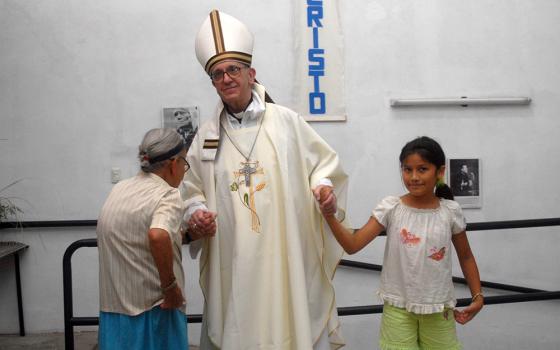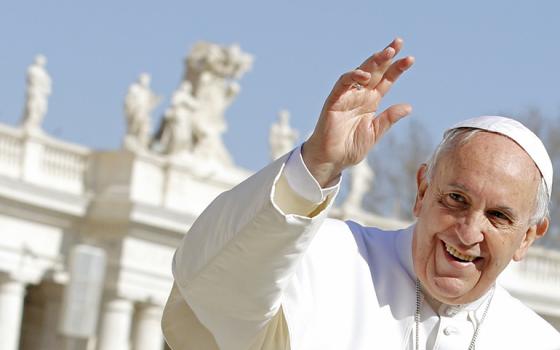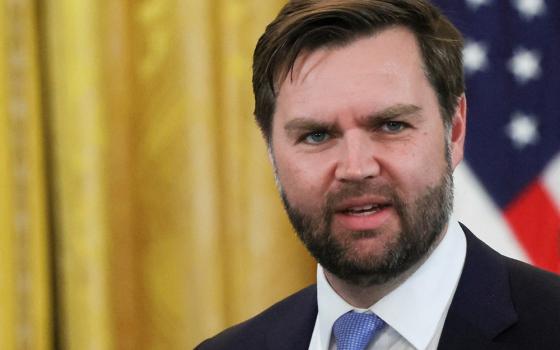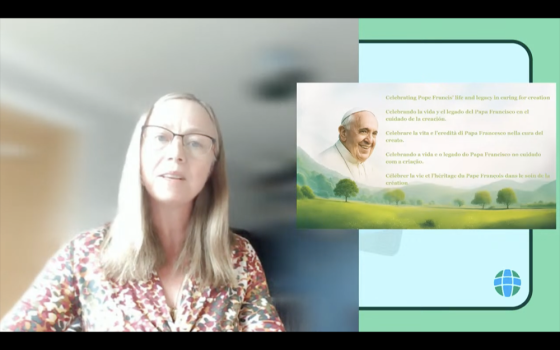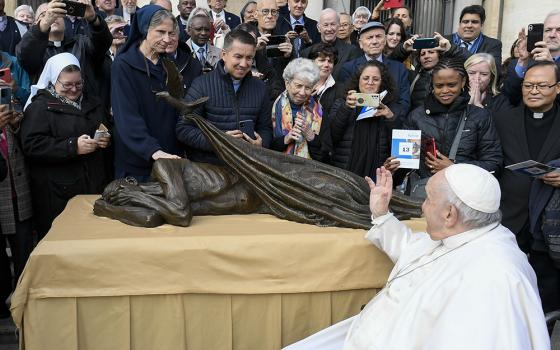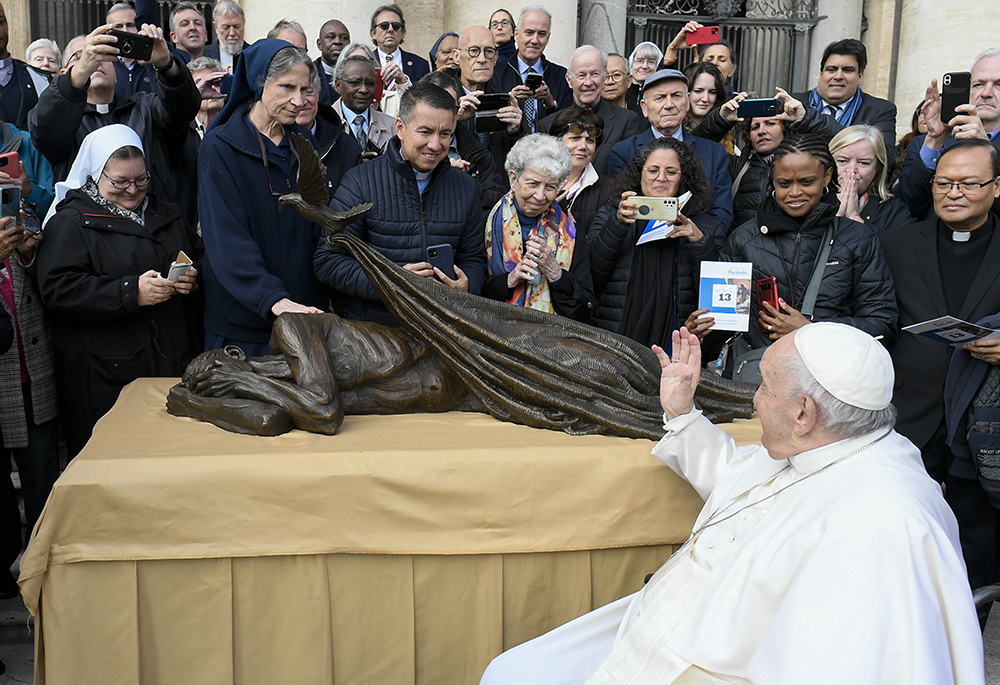
ope Francis waves to members of the Vincentian religious orders and lay communities Nov. 9, 2022, after blessing Canadian artist Timothy Schmalz' sculpture "Sheltering." The statue, which features a dove laying a blanket over a homeless person, was to be used in conjunction with a Vincentian project to build homes for some 10,000 people in 160 countries. (CNS/Vatican Media)
Artists around the globe are paying homage to the late Pope Francis, describing him as a spiritual leader who inspired them to use their art to draw attention to the poor, the environment and peace around the globe.
"Pope Francis thought that artwork was an instrument to promote that spiritual responsibility toward everyone who is marginalized — the forgotten," said Canadian sculptor Tim Schmalz, whose artwork was heavily influenced by the pope's message. "Artwork gives visibility to those who are often invisible."
While Francis, who died April 21 at age 88, will likely be mostly remembered for his pastoral gestures of closeness and welcoming toward marginalized groups, few realize how much art paid a crucial role in the late pope's efforts to broadcast this message. From large-scale sculptures to street art, the Argentine pontiff's legacy outlives him in the art he inspired.
Schmalz first met the pope in St. Peter's Square soon after his election in 2013, where Francis blessed a model of a statue Schmalz made of a homeless man bearing the signs of Jesus' Passion on the cross. The pope was impressed by Schmalz's "radical representation of Jesus," he said, and in 2019, he was asked to create a massive sculpture emphasizing the plight of migrants and refugees, also in St. Peter's Square.
The 20-foot-long bronze statue shows 140 immigrants — including a Jew fleeing Nazi Germany and a Syrian woman — huddled together on a boat with a pair of angel wings emerging from the center. The statue, "Angels Unawares," draws from Hebrews 13:2, "Be welcoming to strangers: for thereby some have entertained angels unawares."
"The pope used artwork, and that piece, to bring out the idea that all life is sacred," Schmalz said.
Advertisement
And just one week before Easter, shortly before the pope died, Schmalz created a new, complementary sculpture to be placed on the other side of the square. Called "Be Welcoming," the artwork shows a figure sitting on a bench. If viewed from one side, it resembles a homeless person, but if one sits next to it, is revealed to be an angel.
Cardinal Konrad Krajewski, who is charged with coordinating the pope's charitable works, suggested placing the statue next to a clinic for homeless patients the pope had built in St. Peter's Square.
Francis also asked for 10 small versions of "Be Welcoming" to gift to people he met at the Vatican, Schmalz said. And he is working on a visual representation of Pope Francis' 2015 environmentally focused encyclical Laudato Si', a lasting testament to the pope's call to care for creation.
"I do believe that his legacy will endure because he was focused on Scripture," Schmalz said. "He was not into the ornamentation — he was into the essence, the distilled truth of what it's like to be Christian."
Mauro Pallotta, born and raised near the Vatican and known as the street artist Maupal, said Francis struck him from the moment he was elected for his simplicity and humility, inspiring Maupal to show the pope's message through his artwork.
After Francis' first trip as pope to the island of Lampedusa, where many migrants trying to come to Europe were stranded, Maupal created graffiti depicting the pope as a superhero. "Super Pope," on a street corner in Rome, became one of the most viral works of street art in history.
"I wanted to portray him as not your ordinary hero — he is wearing glasses and has a bit of a belly, and on his briefcase I wrote the word 'valori,' meaning Christian values, but there is also a scarf emerging from it with the colors of his favorite soccer team," Maupal said. "He is a superhero bringing values, but he is also one of us."
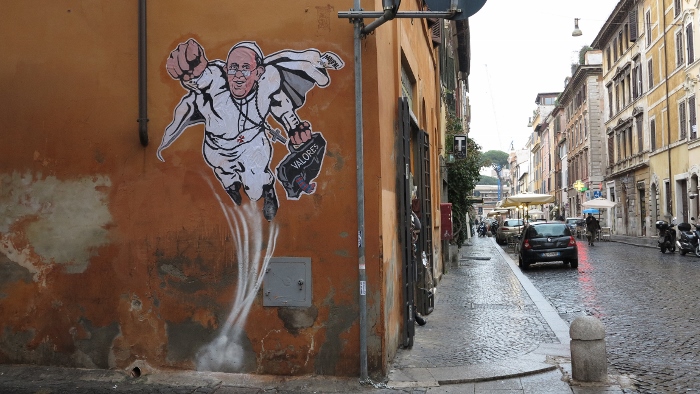
A large drawing of Pope Francis depicting him as a superhero is seen on a wall near the Vatican Jan. 29, 2014. The Argentine pope is shown taking off into the air with his right fist clenched in a classic Superman style. (CNS/Robert Duncan)
Throughout Francis' pontificate, Maupal filled streets with humorous and colorful images of the pope. When Francis advocated for an end to the war in Crimea in 2014, Maupal portrayed the pope painting a graffiti peace sign while a Swiss Guard kept watch.
"In those years, everyone talked about war, except for Pope Francis, who always kept pushing for peace," he said, adding that his work intended to send a message "that it's so prohibited to be pacifists that you need a Swiss Guard to protect you."
Maupal's works were quickly removed soon after he completed them. But he created another one Thursday morning (April 24), depicting the pope's briefcase bearing his values — now with no one to carry it toward peace, in light of Francis' death.
"He was a source of inspiration for many artists, even those who have nothing to do with religion, because he was a transparent person — for better or for worse. A real person," Maupal said. "For me, he was a great example, and great examples never die."
During the 2025 Jubilee of Artists in February, an event celebrating art during the important anniversary of the Catholic Church, Francis was already being treated in the hospital for double pneumonia. Cardinal Tolentino de Mendonça, who headed the Vatican's department for culture and education, read the pope's homily to over 100 artists from around the world, emphasizing that "art is not a luxury, but a necessity for the spirit. It is not an escape, but a responsibility, an invitation to action, a call, a cry."
During a historical juncture where "new walls are raised, in which differences become pretexts for division rather than opportunities for mutual enrichment," artists "are called to build bridges, to create spaces of encounter and dialogue, to illuminate minds and warm hearts," the pope wrote.
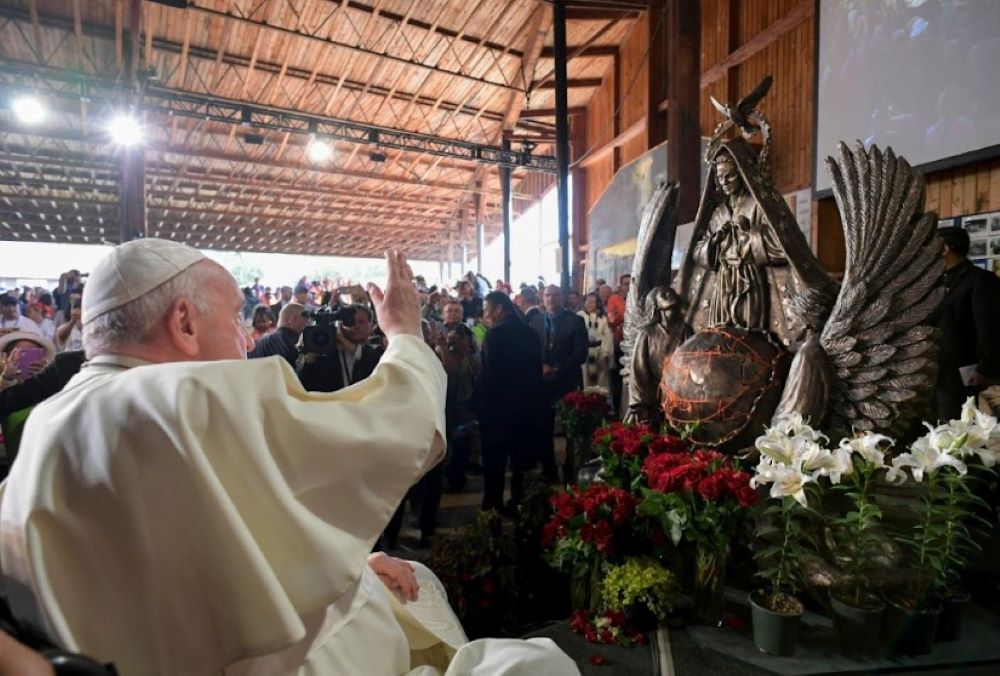
Pope Francis blesses Timothy Schmalz's bronze sculpture. Mary, Untier of Knots, on his second day in Canada, while visiting Lake Ste. Anne, the most popular pilgrimage site for Indigenous peoples in North America. The sculpture will be permanently installed there. (Courtesy of Timothy Schmalz)
In 2024, Francis became the first pontiff to visit the Venice Art Biennale, a world-famous international exhibit for contemporary art, where the Vatican had a pavilion drawing attention to the Giudecca women's prison in Venice. On that occasion, Francis emphasized the importance of female artists, remembering the art of Frida Kahlo, Corita Kent and Louise Bourgeois, and expressing his hope "that contemporary art can open our eyes, helping us to adequately value women's contribution as co-protagonists of the human adventure."
Francis also appointed the first woman to become the director of the Vatican Museums, Barbara Jatta, and promoted the display of modern art in the museums' immense collection.
Moreover, he ordered the restitution of artwork kept at the Vatican to the countries they were originally taken from, underscoring his opposition to modern and ancient forms of colonization. In 2022, Francis asked that Indigenous artifacts kept in the Vatican Museums be returned back to Canada, and a year later he ordered the return of fragments of the Parthenon back to Greece.
The decision also had ecumenical importance because the fragments were sent as a gift to the Orthodox archbishop of Athens and Greece, Hieronymus II — using artwork as a form of diplomacy to cement a working relationship.
Additionally, the pope's book My Idea of Art, written with journalist Tiziana Lupi, emphasized the symbolic and spiritual importance of art for the Argentine pontiff. Art is meant for everyone, according to Francis, a belief best represented by his decision to welcome homeless people for a private viewing of the Sistine Chapel.
Only hours after his death, Neapolitan street artists drew the pope's likeness on the sidewalks of the city. And while these public tributes are destined to fade, they represent the lasting imprint Francis left on art, one many artists agree will endure.
